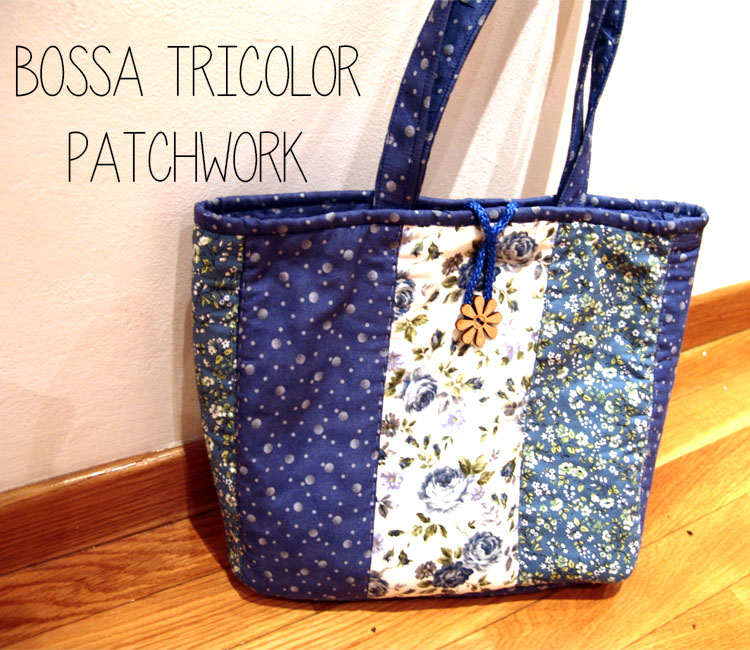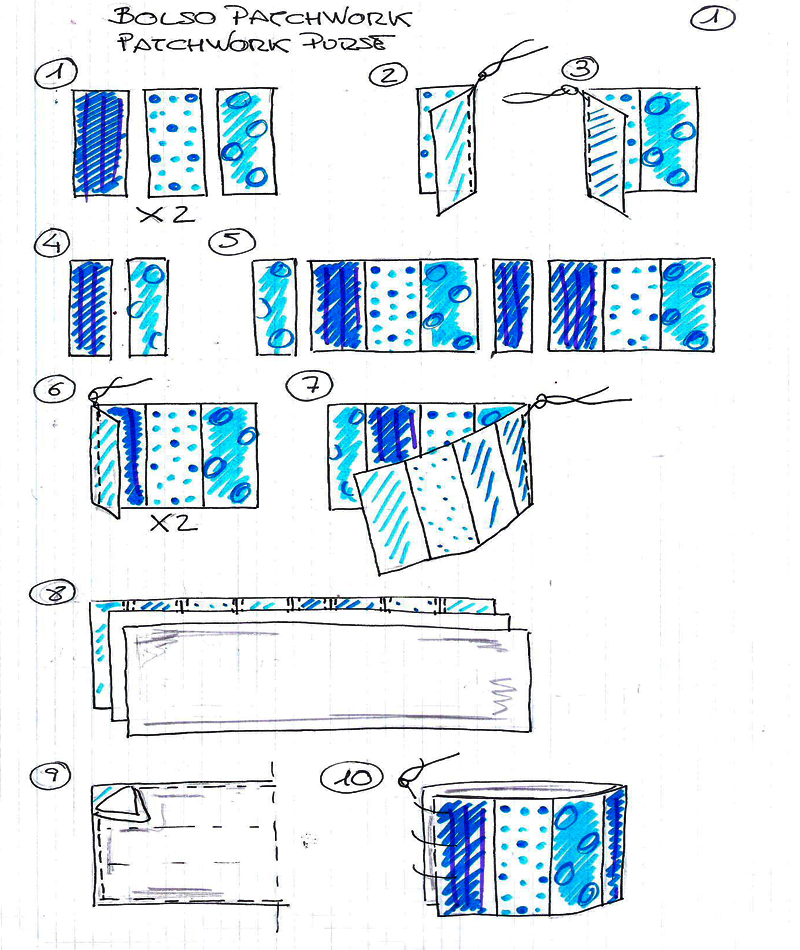TUTORIAL PATCHWORK: BOSSA TRICOLOR.
La mama de les Antònies també fa patchwork i l’última cosa que ha fet ha sigut una estiuenca bossa tricolor.
Ara us explicarem les passes per si voleu fer-vos una vosaltres. No us donarem les mesures exactes perquè, així, podreu fer-la de la mida que més us convingui.
Necessitem 6 retalls de la mateixa mida, d’uns 15cm d’ample i el llarg que creieu adient. Hem fet servir 3 teixits diferents i hem tallat 2 retalls de cada (1). Els hem unit de 3 en 3. Escollim el central i cosim primer el que anirà a la dreta (2) i després el de l’esquerra (3). Ho repetim amb els altres 3 retalls. Ja tenim les dues tapes de la bossa.
Anem pels laterals. Necessitem 2 retalls de la mateixa llargada que els anteriors, però de només 10cm d’ample (4). Cada un l’hem fet de diferent color. Podeu repetir teixit, o fer-ho amb altres de diferents. Els disposem com veieu (5). Unim el lateral de l’esquerra (6) i quan ja estan units a cada tapa, unim les tapes, però no tanquem la bossa (7).
El següent pas és embuatar. Ens cal un tros de buata i tela de coto llisa per fer de folre de la mateixa mida de la tira que tenim (8). Unim les tres capes (bossa, buata, folre) amb 4 costures tot al voltant. I fem l’encoixinat (9). Podeu seguir les tires o fer un dibuix lliure, depèn de la vostra habilitat. Ara ja si que podem unir els dos extrems per formar el cos de la bossa (10).
El fons de la bossael farem amb un retall de la mateixa amplada dels laterals: 10cm i el llarg serà l’ample de la bossa. Nosaltres l’hem arrodonit, però es pot fer recte, és més senzill de cosir (11). Com va embuatat necessitem la mateixa mida de buata i folre (12) i unim les capes amb una costura a tot el voltant (13). No cal encoixinar-ho. Ja podem cosir el fons a la bossa (14).
Evidentment no la deixarem així. Folrarem la bossa. La mama Antònia ho ha fet amb folre de seda, però creiem que pot quedar molt bé amb una tela de cotó estampada, en contrast amb la resta de la bossa. Ha de tenir la mateixa mida de la bossa tant de llarg com d’ample. Si ho podeu fer en una peça, perfecte, si no, ho uniu pel mig i cosiu les costures laterals (15). Introduïm el folre dins la bossa, amb les costures tocant la bossa i la part bonica fora (16).
Toca unir la bossai el folre. Ho farem amb un biaix, que pot ser de tela de patchwork o dels que venen a les merceries en un color contrastat o coordinat amb la bossa (17). Primer es cus la part interior, unint les dues capes (18) i es remata per davant amb un punt ocult (19).
Ja estem acabant. Per fer les nanses tallem dues tires de roba de cotó; les mides depenen del llarg i ample que vulguem. Per fer les nanses més resistents, a l’interior posarem cinta com la de les corretges de les motxilles, de la mateixa mida que les nanses (20).
El procés és senzill: cosim la corretja de motxilla a la tira (21); pleguem la tela i, amb punt amagat, cosim tapant la corretja (22). Encarem i cosim a la bossa les nanses, per l’interior (23).
Ho rematem tot amb una bagueta i un botó de fusta per tancar la bossa (24).
Ja podem gaudir i lluir la nostra bossa d’estiu.
IDEAL PER LA PLATJA O PER SORTIR A PASSEJAR!!!
TUTORIAL PATCHWORK: BOLSO TRICOLOR.
La mamá de les Antònies también hace patchwork y la última cosa que ha hecho ha sido un veraniego bolso tricolor.
Ahora os explicaremos los pasos por si queréis haceros una vosotr@s. No os daremos las medidas exactas porqué, así, podréis hacerla del tamaño que más os convenga.
Necesitamos 6 retales de la misma medida, de unos 15cm de ancho y el largo que creáis conveniente. Hemos usado 3 telas diferentes y hemos cortado 2 retales de cada (1). Los hemos unido de 3 en 3. Escogemos el central y cosemos primero el que irá a la derecha (2) y después el de la izquierda (3). Lo repetimos con los otros 3 retales. Ya tenemos las dos tapas del bolso.
Vamos a por los laterales. Necesitamos 2 retales del mismo largo que los anteriores, pero de solo 10cm de ancho (4). Los hemos hecho de diferente color. Podéis repetir tela, o hacerlo con otras diferentes. Lo disponemos como veis (5). Unimos el lateral de la izquierda (6) y cuando ya están unidos a cada tapa, unimos les tapas, pero no cerramos el bolso (7).
El siguiente paso es enguatar. Necesitamos un trozo de guata y tela de algodón lisa para hacer de forro de la misma medida de la tira que tenemos (8). Unimos las tres capas (bolso, guata, forro) con 4 costuras alrededor. Y lo acolchamos (9). Podéis seguir las tires o hacer un dibujo libre, depende de vuestra habilidad. Ahora ya sí que podemos unir los dos extremos para formar el cuerpo del bolso(10).
El fondo del bolso lo haremos con un retal del mismo ancho que los laterales: 10cm y de largo será la anchura del bolso. Nosotr@s hemos redondeado los extremos, pero se pueden dejar rectos, es más sencillo de coser (11). Como va enguatado necesitamos la misma medida de guata y forro (12); unimos las capas con una costura alrededor (13). No hace falta acolcharlo. Ya podemos coser el fondo albolso (14).
Evidentemente no lo dejaremos así. Forraremos el bolso. La mamá Antònia lo ha hecho con forro de seda, pero creemos que puede quedar muy bien con una tela de algodón estampada, en contraste con el resto del bolso. Ha de ser de la misma medida que el bolso, tanto de largo como de ancho. Si lo podéis hacer de una pieza, perfecto, si no, lo unís por el medio y coséis las costuras laterales (15). Introducimos el forro dentro del bolso, con las costuras tocando el bolso y la parte bonita fuera (16).
Toca unir el bolso y el forro. Lo haremos con un bies, que puede ser de tela de patchworko de los que venden en las mercerías en un color contrastado o coordinado con el bolso (17). Primero se cose la parte interior, uniendo las dos capas (18) y se remata por delante con un punto oculto (19).
Ya estamos acabando. Para hacer las asas cortamos dos tiras de tela de algodón; las medidas dependen del largo y ancho que queramos. Para hacer las asas más resistentes, en el interior pondremos cinta como la de las correas de las mochilas, de la misma medida que las asas (20).
El proceso es sencillo: cosemos la correa de mochila a la tira (21); plegamos la tela y, con punto escondido, cosemos tapando la correa (22). Encaramos y cosemos al bolso las asas, por el interior (23).
Lo rematamos todo con una presilla de cordón y un botón de madera para cerrar el bolso (24).
Ya podemos disfrutar y lucir nuestro bolso de verano.
¡¡¡IDEAL PARA LA PLAYA O PARA SALIR A PASEAR!!!
PATCHWORK TUTORIAL: TRICOLOR PURSE.
The Les Antònies’s mum also makes patchwork and the last thing she has done has been a summery tricolour purse.
Now we will explain the steps if you want to make yourself one. We don’t give you exact measures because, well, you can make it the size that suits you.
We need 6 scraps of the same size, about 15 cm wide and the length that you think appropriate. We used 3 different fabrics and we have cut 2 of each (1). We joined 3 on 3. Choose the central and sew first what will go on the right (2) and then the one on the left (3). You repeat with the other 3 cuts. We already have the two covers of the purse.
And now, the sides. We need 2 cuts of the same length than the previous ones, but only 10 cm in width (4). Each one we’ve done of different colour. You can repeat fabric, or do it with different others. We put them available as you can see (5). Join the side of the left (6) and when they are attached to each lid, join the covers, but do not close the bag(7).
The next step is padding. We need a piece of padding cotton and smooth cotton fabric for lining the same size of the strip that we has (8). Join the three layers (bag, padding cotton, and lining) with 4 stitching all around. And we do the padding (9). You can follow the strips or make a free drawing, depends on your ability. Now if we can unite the two ends to form the body of the bag (10).
We do the bottom of the bag with a trim of the same width of the sides: 10cm and long will be the width of the purse. We’ve rounded up, but can be done straight; it is easier to sew (11). How did padding we need the same size of padding cotton and lining (12) and join the layers with a stitching all around (13). We don’t need quilting it. We can sew the bottom to the purse (14).
Obviously we don’t leave it as well. We’re lining the purse. Mum Antònia has done it with silk lining, but we believe it can be nice with a patterned cotton fabric, in contrast with the rest of the purse. It must have the same size of the purseas long as wide. If you can do this in a piece, it’s perfect, but, if you don’t, you join it through the middle and sew the side seams (15). Introduce the lining inside the purse, with the seams by touching the purse and the right part outside (16).
It’s time to join bag and liner. We will do this with a bias, which can be patchwork fabric or those who sell in the haberdashery in a colour contrasted or coordinated with the purse (17). It is first sewn inside, joining the two layers (18) and topped in front with a blind point (19).
We are already running out. To make the handles cut two strips of cotton clothing; the sizes depend on the length and width that you want. To make the most resistant handles, inside put tape as the straps of backpacks, the same size as the handles (20).
The process is simple: sew the strap of a backpack in the strip (21); fold the fabric and, with hidden point, sew covering belt (22). Face and sew in the bag, the handles to the interior (23).
We finish off everything with a cord clamp and a wooden button to close the purse (24).
We can enjoy and show off our summer purse.
IDEAL FOR THE BEACH OR TO GO OUT FOR A WALK!!!











